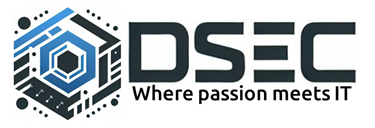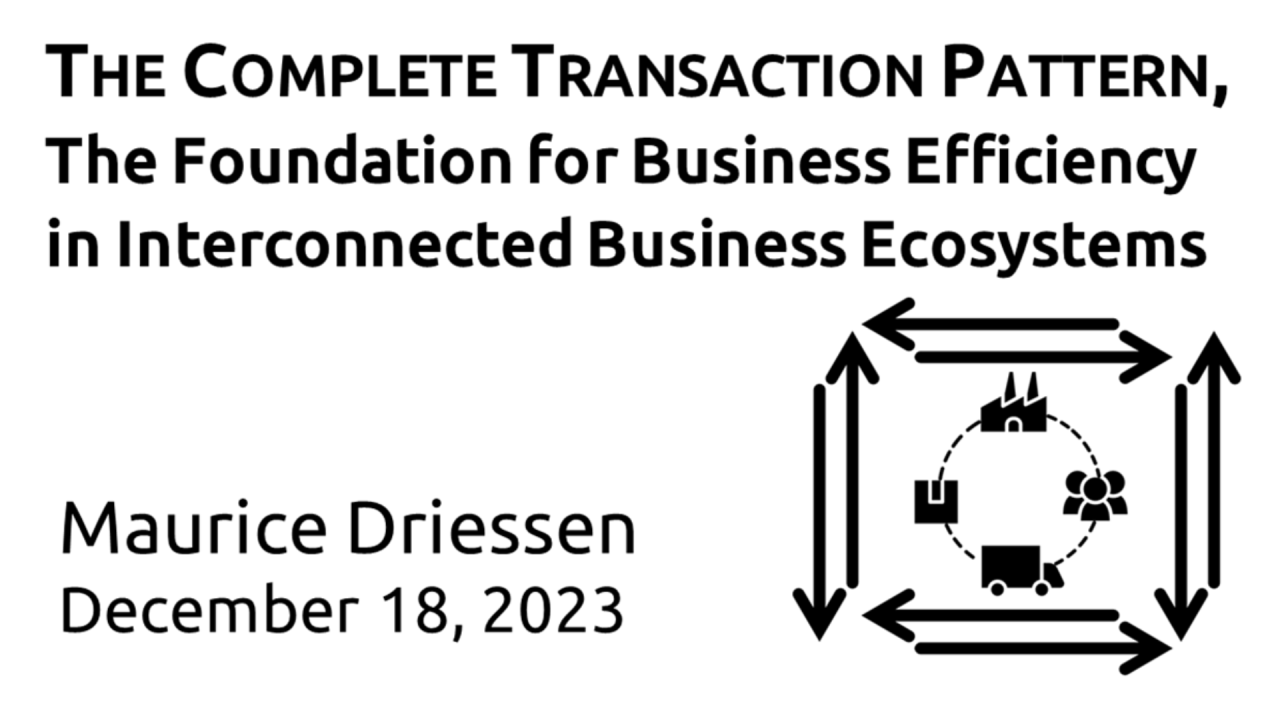In today’s dynamic business landscape, organizations are increasingly interconnected, forming complex and intricate ecosystems to deliver value to customers. Navigating these intricate networks of partners demands seamless collaboration and efficient information exchange. The Complete Transaction Pattern emerges as a transformative solution, offering a universal framework to streamline business transactions and optimize communication across business ecosystems.
The Complete Transaction Pattern provides a standardized and consistent approach to defining, modeling, and executing business transactions, ensuring clarity and alignment among all participants. By decoupling transaction coordination tasks from production activities, the Complete Transaction Pattern fosters efficiency and reduces the risk of disruptions. Moreover, it promotes a common language for communication, facilitating seamless interactions and fostering a more cohesive ecosystem. Discover how this powerful tool can transform your operations, streamline communication, and empower you to achieve greater success.
Introduction to the Complete Transaction Pattern
The Complete Transaction Pattern is a repeatable, predictable pattern that can be used to streamline business transactions between partners in a business ecosystem. When applied the Complete Transaction Pattern is the fundamental construct of all business in the ecosystem.
All production in this ecosystem is established in transactions between two parties through the exchange of intentions which establish the mutually agreed facts required to produce and deliver the product or service which will be the result of the transaction. The exchange of intentions between the two parties and all transactions follows the same basic pattern: requesting, promising, declaring, and accepting, whereby between promising and declaring the production action takes place. For example, John requests the waiter for a cup of coffee and the waiter promises to deliver this cup by means of the statement “But of course, sir.”
Sometimes one of the parties revoke an earlier intention. If the espresso machine turns out to be unexpectedly broken, the waiter will have to revoke his promise to Jan by declaring: “Sorry, Unfortunately I don’t have coffee for you. The espresso machine is broken. Do you want tea?” Jan then accepts or rejects this intention. The basic pattern for transactions is therefore complemented to the by the revocations of a request, promise, declaration, and acceptance, which may or may not be accepted by the counterparty.
When a client and contractor enter a business transaction, the transaction is also governed by the code of law and contracts between the parties. An implementation of the pattern can codify to rules of engagement agreed in these contacts. The pattern decouples the transaction coordination tasks embedded in the pattern and the production tasks. During the order phase the pattern assures both parties agree upfront on the quality of the work which is expected within the constraints of the agreed contracts before work orders are going to production, this mitigating the risk of interruptions during production due to incomplete or unclear work orders. During the result phase the patterns assures both parties agree the delivered result meets the agreed quality, again within the constraints of the agreed contracts. The pattern improves the efficiency of the transaction coordination. By using the Complete Transaction Pattern, businesses can reduce the amount of time and resources spent on transactional tasks. This will allow supply chain members to focus on their core competencies and grow their businesses.
A Foundation for Business Ecosystem Design and Optimization
Because the Complete Transaction Pattern is the fundamental construct of a business transaction, the pattern can be used as the foundation of the design of a business ecosystem’s value stream and the implementation the information supply chain which supports the business ecosystem.
DEMO, the Design & Engineering Methodology for Organizations, a business modeling methodology rooted in the complete transaction pattern. DEMO approach for organizational understanding, and design of a business ecosystem is focusing on transactions rather than organizational structures or processes. Its principles prioritize communication, coordination, and a holistic understanding of the organization, fostering enhanced process efficiency and increased agility. With applications ranging from modeling core business processes to interactions in networked environments, DEMO is a powerful tool for organizations seeking to elevate efficiency, agility, and communication in an increasingly complex and interconnected business ecosystem.
Advantages of the Complete Transaction Pattern in the Business Ecosystem
There are several advantages to leveraging the Complete Transaction Pattern in the business ecosystem.
- It can improve business efficiency by streamlining communication between partners.
- It can help improve coordination between partners, leading to a more efficient and cohesive ecosystem.
- It can help reduce the time spent on coordinating the transaction, which can speed up transactions and saves money.
- It can provide a common language that everyone in the ecosystem can understand, making communication easier and faster.
Potential Concerns and Risks Associated
When applied to a business ecosystem, the Complete Transaction Pattern can help improve efficiency and communication.
However, there are some potential concerns and risks associated with its implementation. One such risk is that implementation of the pattern in enterprise information systems may not be compatible across all business partners. This could lead to communication breakdowns and business inefficiencies. Businesses need to ensure that all partners in the ecosystem are aligned on the pattern and the specific implementation of the pattern for specific types of business transaction. If not, the results could be disastrous.
Another concern is that the Complete Transaction Pattern may seem too complex and difficult to understand due to lack of knowledge and experience. This could lead to confusion and cause errors in the information supply chain which process the transactions.
Overall, the benefits of using the Complete Transaction Pattern outweigh the risks. However, businesses should consider the potential concerns before implementing it for maximum efficiency.
Strengths and Weaknesses of the Pattern
Now that we understand how the Complete Transaction Pattern can be applied in business ecosystems, let’s take a closer look at its strengths and weaknesses.
On the plus side, the pattern is very versatile and can be adapted to many different situations.
The product, which is the result of a business transaction in a supply chain, is in almost all cases the result of a series of transactions between a manufacturer and its subcontractors who supply parts for this product. Even the waiter from the example above will have to buy coffee beans for a cup of coffee. By encoding all transactions in a supply chain according to the pattern, it is possible to easily obtain a universal overview of all transactions and their status across the entire supply chain.
On the downside, the pattern is relatively new and so isn’t yet widely used or understood. This could make it difficult to get buy-in from partners in a business ecosystem. It’s also not easy to implement the pattern in the information supply chain as it does require standards and infostructure which codify all types of transactions according to the pattern across the supply chain.
Exploring Opportunities while Navigation Challenges
When you apply the Complete Transaction Pattern to your information supply chain, you open new opportunities for your business. For example, you can:
- Create a more efficient and streamlined process for passing information between partners.
- Identify potential bottlenecks and areas of improvement in the supply chain.
- Gain insights into how partners are using your information.
On the flip side, there are also some challenges that you should be aware of. These include:
- Codifying the transactions according to the pattern and the business contracts in a supply chain is no trivial task. The pattern is relatively new the required knowledge and experience is scarce and difficult to source.
- The pattern is also not available as a feature in the ERP information systems which govern the business transactions between parties. To add the pattern to a supply chain an investment is required to implement the pattern across the supply chain.
- Codifying business transactions according to the pattern in is also a task which must be done by all parties in the supply chain. This amplifies the sourcing risk and multiplies the investment required across the entire information supply chain.
However, partners who want to take advantage of the pattern can mitigate the sourcing risk and reduce their individual investment, through a joint investment in the implementation of the pattern. An implementation which results in standards and components which can be shared among the partners.
Business Case and Benefits
The application of the Complete Transaction Pattern has many benefits for businesses. Perhaps the most obvious benefit is increased efficiency. By using the Complete Transaction Pattern, businesses can avoid the need to recreate the wheel every time they need to engage in a new kind of business transaction. This saves time and resources that can be better spent on other areas of the business.
Another benefit of using this pattern is that it can help to create a more seamless flow of information between partners in a business ecosystem. This can lead to improved communication and collaboration, which can ultimately result in better business outcomes.
If you’re looking to improve the efficiency of your business ecosystem, the Complete Transaction Pattern is a good place to start.
Conclusion
The Complete Transaction Pattern holds the potential to revolutionize business efficiency and effectiveness by eliminating duplication, enhancing data exchange, and fostering seamless communication. However, implementing this pattern requires a significant shift in business design practices, and there’s no guarantee that the benefits will fully offset the associated costs.
Given the potential rewards and risks, careful evaluation is crucial. Businesses should thoroughly assess the applicability of the pattern within their industry and make informed investment decisions based on their unique needs and aspirations.

